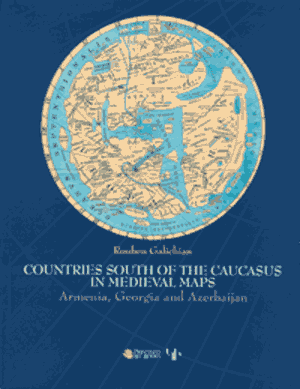
Countries South of the Caucasus in Medieval Maps: Armenia, Georgia and Azerbaijan
co-publication, Gomidas Institute (London)
and Artinfo Art Books (Yerevan), 2007,
208 pp, 82 maps and 24 details,
98 in full color,
ISBN 978-1-903656-69-3, paperback,
UK£30.00 / US$50.00
To order please contact books@gomidas.org
"Excellent work" - Journal of International Map Collectors Society
This cartographic study is dedicated to the geography of countries located south of the Caucasian range of mountains, as depicted on medieval maps.
The third millennium has already witnessed the steady eastward expansion of the borders of the European Union, which now includes many Eastern European, as well as some of the ex-Soviet republics. Even Turkey, with over 97% of its territory firmly rooted in what is geographically known as "Asia Minor", has aspirations of becoming part of this Union. had it not been for some unresolved political issues, she might have already become a member state.
Thus, the borders of the European Union are being pushed further to the east and the Union is sharing common borders with countries whose history and geography remains obscure even to the well-educated class of western Europeans. if, one day, Turkey succeeds in joining the Union, Europe, on its south-east, will share common borders with Syria, Iraq, Iran, Azerbaijan, Armenia and Georgia.
The aim of the present work is to familiarize the reader with medieval historical cartography centering on the latter three of the above-mentioned countries: those situated south of the Caucasus range.
ABOUT THE AUTHOR: Rouben Galichian was born in Tabriz, Iran, to a family of immigrant Armenians who had fled Van in 1915 and arrived in Iran via Armenia, Georgia and France. After attending school in Teheran he received a scholarship to study in the UK and graduated from the University of Aston, Birmingham, in engineering. His interest in geography and cartography started early in life but he began seriously studying this subject in the 1970s. In 1981 he moved to London with his family, where he had access to a huge variety of cartographic materials. His first book on this subject was Historic Maps of Armenia: The Cartographic Heritage (I. B. Tauris, London, 2004). The present volume is the result of his studies and research on medieval western and Islamic maps of the region south of the Caucasus.
The third millennium has already witnessed the steady eastward expansion of the borders of the European Union, which now includes many Eastern European, as well as some of the ex-Soviet republics. Even Turkey, with over 97% of its territory firmly rooted in what is geographically known as "Asia Minor", has aspirations of becoming part of this Union. had it not been for some unresolved political issues, she might have already become a member state.
Thus, the borders of the European Union are being pushed further to the east and the Union is sharing common borders with countries whose history and geography remains obscure even to the well-educated class of western Europeans. if, one day, Turkey succeeds in joining the Union, Europe, on its south-east, will share common borders with Syria, Iraq, Iran, Azerbaijan, Armenia and Georgia.
The aim of the present work is to familiarize the reader with medieval historical cartography centering on the latter three of the above-mentioned countries: those situated south of the Caucasus range.
ABOUT THE AUTHOR: Rouben Galichian was born in Tabriz, Iran, to a family of immigrant Armenians who had fled Van in 1915 and arrived in Iran via Armenia, Georgia and France. After attending school in Teheran he received a scholarship to study in the UK and graduated from the University of Aston, Birmingham, in engineering. His interest in geography and cartography started early in life but he began seriously studying this subject in the 1970s. In 1981 he moved to London with his family, where he had access to a huge variety of cartographic materials. His first book on this subject was Historic Maps of Armenia: The Cartographic Heritage (I. B. Tauris, London, 2004). The present volume is the result of his studies and research on medieval western and Islamic maps of the region south of the Caucasus.